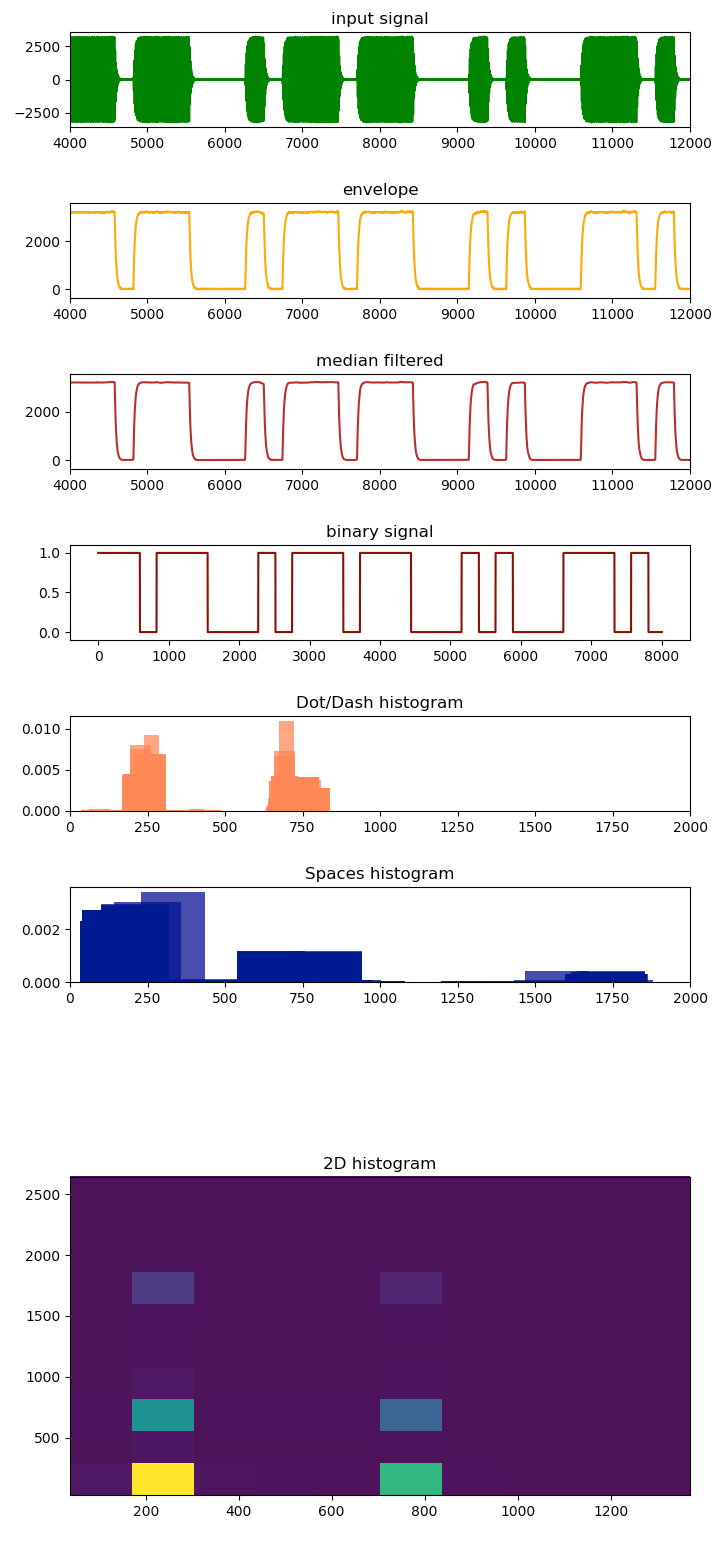import pyaudio
import numpy as np
import matplotlib.pyplot as plt
import time
import sys
from scipy.signal import hilbert
from scipy.signal import medfilt
from sklearn.cluster import KMeans
CHUNK = 8001
FORMAT = pyaudio.paInt16
CHANNELS = 1
RATE = 8000
x = range (CHUNK)
y = np.zeros(CHUNK)
binary = np.zeros(CHUNK)
xx = range (CHUNK*2)
yy = np.zeros(CHUNK*2)
fig1 = plt.figure(1, figsize=(8, 19))
fig1.subplots_adjust(hspace=0.8, wspace=0.1)
ax1 = fig1.add_subplot(9,1,1)
ax1.set_xlim(CHUNK/2,CHUNK+CHUNK/2)
lines1, = plt.plot(xx,yy, color="green")
plt.title('input signal')
ax2 = fig1.add_subplot(9,1,2)
ax2.set_xlim(CHUNK/2,CHUNK+CHUNK/2)
lines2, = plt.plot(xx,yy, color="orange")
plt.title('envelope')
ax3 = fig1.add_subplot(9,1,3)
ax3.set_xlim(CHUNK/2,CHUNK+CHUNK/2)
lines3, = plt.plot(xx,yy, color="firebrick")
plt.title('median filtered')
ax4 = fig1.add_subplot(9,1,4)
lines4, = plt.plot(x,y, color="maroon")
plt.title('binary signal')
ax5 = fig1.add_subplot(9,1,5)
lines5 = plt.hist(x, density=True, alpha= 0.75, color="white")
plt.title('Dot/Dash histogram')
ax6 = fig1.add_subplot(9,1,6)
lines6 = plt.hist(x, density=True, alpha= 0.75, color="white")
plt.title('Spaces histogram')
up_2 = np.random.randn(200)
down_2 = np.random.randn(200)
ax8 = fig1.add_subplot(3,1,3)
lines8 = plt.hist2d(up_2, down_2)
plt.title('2D histogram')
y_buf = np.zeros(CHUNK*2)
time_base = 0
count = 0
trig_count = 0
t_up = 0
t_down = 0
binary_b4 = 0
up = []
down = []
p = pyaudio.PyAudio()
def callback(in_data, frame_count, time_info, status):
global y_buf, z_buf, window, yy
global time_base, count, trig_count, t_up, t_down, binary_b4, up, down
global ax6, ax7, lines6, lines7
y = np.frombuffer(in_data, dtype="int16")
for i in range(CHUNK):
y_buf[i ] = y_buf[i+CHUNK]
y_buf[i+CHUNK] = y [i]
analytic_signal = hilbert(y_buf)
envelope = np.abs(analytic_signal)
nmedian = 51
medsignal = medfilt(envelope, nmedian)
y_max = max(1.1 * max(abs(y.min()), abs(y.max())), 100.0)
y_buf_max = max(1.1 * max(abs(y_buf.min()), abs(y_buf.max())), 100.0)
envelope_max = max(1.1 * abs(envelope.max()) , 100.0)
medsignal_max = max(1.1 * abs(medsignal.max()), 100.0)
th = 0.4*medsignal_max
for i in range(CHUNK):
if medsignal[i+CHUNK//2] > th:
binary[i] = 1
else:
binary[i] = 0
for i in range(CHUNK):
if binary_b4 == 0 and binary[i] == 1:
if trig_count == 0:
trig_pos = i
trig_count += 1
t_up = i+count*CHUNK
t_down_duration = t_up - t_down
if trig_count > 1:
down.append(t_down_duration)
if binary_b4 == 1 and binary[i] == 0 and trig_count > 0:
t_down = i+count*CHUNK
t_up_duration = t_down - t_up
up.append(t_up_duration)
binary_b4 = binary[i]
print('count =', count, ', len(up)=', len(up), ', len(down) =', len(down))
if count%10 == 0:
ax1.set_ylim(-y_buf_max, y_buf_max)
ax2.set_ylim(-0.1*envelope_max, envelope_max)
ax3.set_ylim(-0.1*medsignal_max, medsignal_max)
ax4.set_ylim(-0.1, 1.1)
ax5.set_xlim((0,2000))
ax6.set_xlim((0,2000))
lines1.set_data(xx,y_buf)
lines2.set_data(xx,envelope)
lines3.set_data(xx,medsignal)
lines4.set_data(x,binary)
ax5.hist(up, density=True, alpha=0.75, color="coral")
ax6.hist(down, density=True, alpha=0.75, color="darkblue")
'''
if len(up) > 200 and len(down) > 200:
for i in range(200):
up_2[i] = up[i]
down_2[i] = down[i]
ax8.hist2d(up_2, down_2)
'''
if len(up) == len(down):
ax8.hist2d(up,down)
print('*')
count += 1
return (None, pyaudio.paContinue)
stream = p.open(format=FORMAT, channels=CHANNELS, rate=RATE,
input=True, frames_per_buffer=CHUNK,
stream_callback=callback)
stream.start_stream()
while stream.is_active():
plt.pause (0.01)
time.sleep(0.01)
stream.stop_stream()
stream.close()
p.terminate()

Ham Radio Blog
